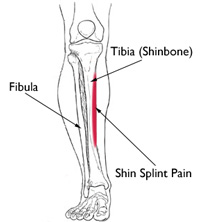What is a Shin Splint?
 If you have heard of the term Medial Tibial Stress Syndrome (MTSS) before, then you may be familiar with the well-known injury of shin splints. This is a very common over-use injury known to a variety of people who run or participate in running type activities such as tennis, squash, soccer, basketball or even aggressive walkers. They can be brought on by such activities as running downhill, running on uneven surfaces or even using improper footwear. If you have heard of the term Medial Tibial Stress Syndrome (MTSS) before, then you may be familiar with the well-known injury of shin splints. This is a very common over-use injury known to a variety of people who run or participate in running type activities such as tennis, squash, soccer, basketball or even aggressive walkers. They can be brought on by such activities as running downhill, running on uneven surfaces or even using improper footwear.
Shin splints are typically the result of excessive activity that pertains to the shin bones and the muscles around that supports it. You can also experience shin splints if there are small bone fractures due to the constant pressure of running activities that create miniature cracks in the tibia bone of the leg. Both cases of shin splints will need ample time to rest and recover in order to heal properly.
Shin splints are typically characterized as mild to extreme pain in the lower leg, around the shin bone, or tibia. You may notice some swelling of the muscle tissue around the shin bones or have soreness on the site. The pain typically stays within the leg range between the knee and down to the ankle. You may feel numb or weak in the affected leg due to the swelling of the muscles that irritate the nerves.
The severity of a shin split injury can vary significantly from person to person depending on many factors including the activity, the type of shoes the person has, the way they perform the said activity and their muscle tone. The intensity of the shin splint injury will also depict how long the recovery process is and what the individual needs to do in order to alleviate the pain while recovering.
An increase in shin splint injuries can occur when you intensify your activity level. You may find that one leg is more prone to shin splints than the other, or you may feel the effects in both legs. The best course of action is knowing what shin splints are and how to avoid them so that you don't suffer. If you do find yourself with this type of injury, you will need to treat it accordingly to help speed up your recovery process so you can return your activity level back to normal.
Several treatments are available that you should partake in when dealing with shin splints. Icing the affected area will help keep the swelling down in the leg, which will also help control the pain due to the pressure of the strained muscle tissues against the nerves in the leg. Some individuals will take anti-inflammatory medication as well to control the swelling of tissue during the healing process. Rest is extremely important during the recovery process so that your body can heal properly and completely before resuming regular activity.
Of course, there are ways to speed up the healing of shin splints dramatically, as detailed in "Stop Shin Splints Forever (Fully Illustrated)" by Gary Buchenic, a personal trainer and rehab specialist. This guide lays out the program that elite athletes use to eliminate shin splints completely in just 3 days.
|